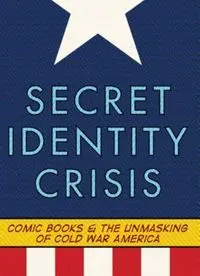
Secret identity Crisis: Comic Books and the Unmasking of Cold War America PDF
Preview Secret identity Crisis: Comic Books and the Unmasking of Cold War America
Secret Identity Crisis This page intentionally left blank Secret Identity Crisis Comic Books and the Unmasking of Cold War America MATTHEW J. COSTELLO 2009 The Continuum International Publishing Group Inc 80 Maiden Lane, New York, NY 10038 The Continuum International Publishing Group Ltd The Tower Building, 11 York Road, London SE1 7NX www.continuumbooks.com Copyright © 200 9 by Matthew J. Costello All rights reserved. No part of this book may be reproduced, stored in a retrieval system, or transmitted, in any form or by any means, electronic, mechanical, photocopying, recording, or otherwise, without the written permission of the publishers. Library of Congress Cataloging-in-Publication Data Costello, Matthew J. (Matthew John), 1963– Secret identity crisis : comic books and the unmasking of Cold War America / by Matthew J. Costello. p. cm. Includes bibliographical references and index. ISBN-13: 978-0-8264-2997-1 (hbk. : alk. paper) ISBN-10: 0-8264-2997-1 (hbk. : alk. paper) ISBN-13: 978-0-8264-2998-8 (pbk. : alk. paper) ISBN-10: 0-8264-2998-X (pbk. : alk. paper) 1. Comic books, strips, etc.— Social aspects — United States. 2. Comic books, strips, etc.—Political aspects —United States. 3. Cold War—Influence. I. Marvel Comics Group. II. Title. PN6725.C69 2009 741.5'30973 — dc22 2008030564 Printed in the United States of America 9780826429407 Contents 1 I Acknowledgments vii Introduction 1 The Cold War and the Forging of the Liberal Consensus 31 2 I The Enemy Without: 1961–1968 58 3 I The Enemy Within: 1969 –1976 85 4 I Retreat into Privacy: 1977–1985 126 5 I Betrayal in the Mirror: 1986 –1996 162 6 I The New World Order: 1996 –2007 195 7 I Civil War and the Death of Captain America 229 Notes 243 Bibliography 267 Index 285 This page intentionally left blank Acknowledgments IT IS COMMONPLACE TO NOTE that any academic work is a collaborative effort, and this is no exception. One of the joys of finishing such a project is finally thanking everyone who helped make it possible, and I have many thanks to offer. At Continuum, David Barker and his fellow editors were supportive and critical. Carol Pinkus of Marvel Comics helped secure permissions for the artwork that Marvel has graciously allowed me to reproduce in this book. Portions of chapter 6 were presented at the American Studies Association Annual Meeting in Atlanta, November, 2004. At Saint Xavier University, a semester sabbatical and financial support from the Center for Educational Practice helped secure materials necessary for research (and yes, I bought comic books with your money). Conversations with colleagues, including Judy Hiltner, Michael Bathgate, and Karen Benjamin, and with several classes of students helped refine my thinking on several of the issues treated in this book. Nelson Hathcock has been particularly helpful, listening to me often, reading through several drafts, and offering insightful and graceful criticism. Carl Bonasera of All American Comics in Evergreen Park, Illinois, was a font of information and ideas, a knowledgeable analyst of the comic industry and the books. These colleagues gave their time and expertise to improve this project; any flaws are the product of my own limitations. Finally, three generations of Costellos have helped make this book possible. My parents indulged my early fascination with superhero comics, although my father always wondered about the attraction of the “goddamned funny books.” My wife, Cathy, has been a constant source of support, inspiration, and criticism; she has read several portions of the manuscript, offered astute criticism, and has graciously suppressed her embarrassment vii viii Acknowledgments at the boxes of “research materials” in our basement. My sons, Ethan and Dylan, have been both a major inspiration and at times a welcome distraction. They are my true superheroes. I dedicate this book to my family, without whom it never would have come to be. Introduction HYSICIST BRUCE BANNER, caught in the nuclear explosion of his gamma bomb, is transformed into the rampaging green monster the Hulk. High school student Peter PParker,experimental bitten by an irradiated spider, gains the powers of the spider and becomes Spider-Man. Reed Richards and his friends are caught in a belt of cosmic radiation while orbiting Earth in a spacecraft and are transformed into the Fantastic Four. Human teenagers develop superpowers through genetic mutations as a result of increased radiation in the atmosphere and are organized as the X-Men. Matt Murdock, blinded by an accident with radioactive waste as a child, develops superhuman senses and becomes Daredevil. While Stan Lee suggests he clung to the hackneyed idea of radioactivity in creating Marvel’s stable of superheroes because of his limited imagination,1 radiation and the bomb are nonetheless the big bang that spawned the “Marvel universe.” The Marvel superhero comic that came to dominate the comic book industry for most of the last five decades was born under the mushroom cloud of potential nuclear war that was a cornerstone of the four-decade bipolar division of the world between the United States and the USSR. These stories were consciously set in this world and reflected the changing culture of Cold War (and post-Cold War) America; they thus provide a very useful avenue through which to explore the political culture of the period. Like other forms of popular entertainment, comic books tend to be very receptive to cultural trends, to reflect them, comment on them, and sometimes inaugurate them. The Marvel comics of the 1960s and 1970s were seen at the time by their readers as engaged with the contemporary political and social cultures and, as such, were widely read not only by adolescents, but by college 1
